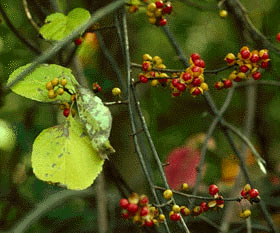
Hakea is a genus of about 150 species of plants in the Family Proteaceae and are endemic to Australia. They are shrubs or small trees with leaves that are sometimes flat, otherwise circular in cross section in which case they are sometimes divided. The flowers are usually arranged in groups in leaf axils and resemble those of other genera, especially Grevillea. Hakeas have woody fruit which distinguishes them from grevilleas which have non-woody fruit which release the seeds as they mature. Hakeas are found in every state of Australia with the highest species diversity being found in the south west of Western Australia.

Eremophila is a genus of more than 260 species of plants in the figwort family, Scrophulariaceae all of which are endemic to mainland Australia.. Eremophilas are widespread in the arid areas of Australia, especially Western Australia and range in size from low-growing shrubs to small trees. The petals are joined, at least at their bases, into a tube with the upper petals different in size and shape from the lower ones. Some species have common names including emu bush, poverty bush or fuchsia bush, reflecting the belief that emus eat the fruit, their arid environment or a superficial resemblance to the flowers of plants in the genus Fuchsia.

Hakea scoparia is a shrub which is endemic to shrubland in south-west Western Australia.

Eremophila scoparia, commonly known as silver emubush, is a flowering plant in the figwort family, Scrophulariaceae and is endemic to Australia. It is a broom-like shrub with narrow, hooked leaves, small sepals and deep lilac-coloured to white petals and is common and widespread in southern parts of the continent.

Stackhousia is a genus of annual and perennial plants in the family Celastraceae that are native to Australia, New Zealand, Malesia and Micronesia. The genus was first described by James Edward Smith in Transactions of the Linnean Society of London in 1798.

Jacksonia scoparia, commonly known as dogwood, is a native species of a pea-flowered, greyish, leafless, broom-like shrub or small tree that occurs in the south east of Queensland, Australia and eastern New South Wales.
Stackhousia subterranea is a perennial herb species in the family Celastraceae. The species occurs in South Australia and Victoria and Tasmania

Richea scoparia is a species of flowering plant in the family Ericaceae. It is endemic to Tasmania, Australia where it is an abundant plant of mountains.

Comesperma scoparium, commonly known as broom milkwort, is a small broom-like shrub of the family Polygalaceae. It usually grows to between 0.3 and 1.2 metres high and produces blue flowers between February and November in its native range.

Stackhousia viminea the Slender Stackhousia is a common small Australian plant. It grows to 70 cm tall. The habitat is heathland, pastures, eucalyptus woodland and forest, usually in moist areas. It features attractive yellowish/red flowers. The specific epithet viminea refers to the slender stems. The genus is named after the botanist and artist, John Stackhouse

Stackhousia monogyna, commonly known as creamy stackhousia or creamy candles, is a perennial herb species in the family Celastraceae. It is native to Australia. Plants grow to 70 cm (28 in) high and produce a terminal spike of white, cream or yellow flowers between August and January in the species native range.
Monotoca oreophila, commonly known as mountain broom heath, is a plant in the heath family. It is endemic to Victoria, Australia. Plants grow to between 0.2 and 2.5 metres high. The elliptic or lanceolate leaves are 3.8 to 11 mm long and 1.4 to 2.8 mm wide. They are stiff, convex and pointed at the apex. The upper surface of the leaves is dark green while the underside is white with distinct veins. White flowers appear between November and January in the species native range. These are followed by fruits that ripen to orange-red between January and April.
Astartea scoparia, commonly known as common astartea, is a shrub endemic to Western Australia.

Stackhousia clementii is a species of plant in the Celastraceae family.
Stackhousia dielsii, commonly known as yellow stackhousia, is a species of plant in the Celastraceae family.
Stackhousia huegelii is a species of plant in the Celastraceae family.

Stackhousia muricata is a species of plant in the Celastraceae family.
Stackhousia pubescens, commonly known as downy stackhousia, is a species of plant in the Celastraceae family.
Stackhousia stratfordiae is a species of plant in the Celastraceae family.
Stackhousia umbellata is a species of plant in the Celastraceae family.














